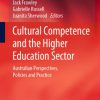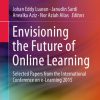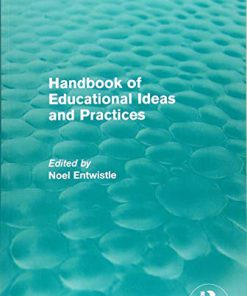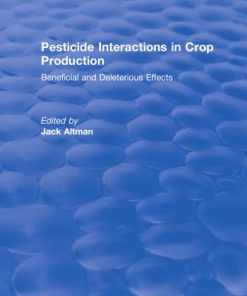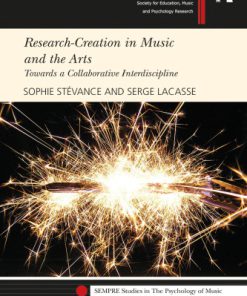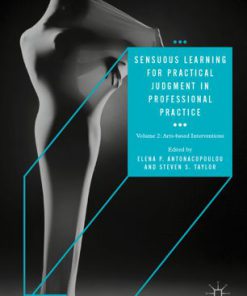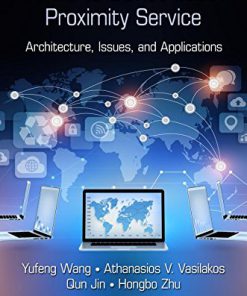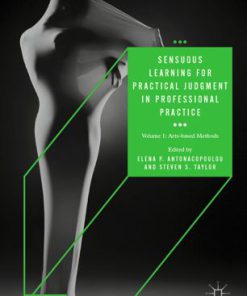Engaging First Peoples in Arts Based Service Learning 1st edition by BrydieLeigh Bartleet,Dawn Bennett,Anne Power,Naomi Sunderland 9783319221533 3319221531
$50.00 Original price was: $50.00.$25.00Current price is: $25.00.
Engaging First Peoples in Arts Based Service Learning 1st edition by BrydieLeigh Bartleet,Dawn Bennett,Anne Power,Naomi Sunderland – Ebook PDF Instant Download/Delivery:9783319221533,3319221531
Full download Engaging First Peoples in Arts Based Service Learning 1st edition after payment
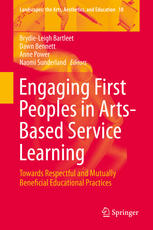
Product details:
ISBN 10:3319221531
ISBN 13:9783319221533
Author:BrydieLeigh Bartleet,Dawn Bennett,Anne Power,Naomi Sunderland
This volume offers educators, higher education institutions, communities and organizations critical understandings and resources that can underpin respectful, reciprocal and transformative educative relationships with First Peoples internationally. With a focus on service learning, each chapter provides concrete examples of how arts-based, community-led projects can enhance and support the quality and sustainability of First Peoples’ cultural content in higher education. In partnership with communities across Australia, Aotearoa New Zealand, Canada and the United States, contributors reflect on diverse projects and activities, offer rich and engaging first-hand accounts of student, community and staff experiences, share recommendations for arts-based service learning projects and outline future directions in the field.
Engaging First Peoples in Arts Based Service Learning 1st Table of contents:
Part I: Framing and Conceptualizing Arts- Based Service Learning with First Peoples
Reference
Arts-Based Service Learning with Australian First Peoples: Concepts and Considerations
1 Introduction
2 Service Learning with First Peoples
3 Arts-Based Service Learning
4 Case Studies of Arts-Based Service Learning with Australian First Peoples
5 Key Concepts and Considerations
6 Positioning Ourselves
7 Stories, Experiences, and Methods to Support Respectful and Mutually Beneficial Educational Pra
References
Translating Indigenous Reciprocity into University-Led Arts Practice and Assessment
1 Introduction
2 What Universities Offer
3 Identities in the Academy, Identities in Our Engagements
4 Arts-Based Service Learning
5 First Peoples, Communities: Terminologies and Expectations
6 Will Students Have a Cultural Experience, and Will Reciprocity Ensure It?
7 A Creative Undertaking: Reciprocity as a Long-Developed Learning Tool
8 A ‘How-to’ Manual for Service Learning in Arts Contexts
9 Students Are Not a Blank Slate: Understanding, Assessment and the Future
10 Translating Indigenous Reciprocity into University-Led Arts Practice and Assessment
References
Exploring University-Community Partnerships in Arts-Based Service Learning with Australian First P
1 Introduction
2 Conceptualizing Partnerships in Service Learning
3 Benefits and Challenges Associated with Partnerships in Service Learning
4 Positioning Ourselves and Our Work
5 Conceptualizing Partnerships in the Winanjjikari Service Learning Program
6 Developing Transformational Partnerships in the Winanjjikari Service Learning Program
7 “Making Space” for Intercultural Partnerships in the Winanjjikari Service Learning Program
8 Conclusions
References
Finding Common Ground: Combining Participatory Action Research and Critical Service-Learning to Gu
1 Introduction
2 Combining Participatory Action Research and Critical Service Learning
3 Finding Common Ground
3.1 Look: Collaborative Data Gathering
3.2 Think: Listen, Reflect and Think
3.3 Act: Research that Results in Action
4 A Partnership in Action
4.1 The Planning
4.2 Parameter One: Work Within the Local Community
4.3 Parameter Two: Enable Relationships to Develop Over Time
4.4 Parameter Three: Share the Process and Product with the Wider Community
4.5 Parameter Four: Establish a Balance between Process and Product
4.6 The Delivery
4.7 The Results
5 Participatory Action Research Challenges
6 Closing Comments
References
I’ll Paint you a Picture and You’ll Hear my Story: Broadening the Scope of Narrative Resear
1 Introduction
2 Written and Spoken Narrative as a Dominant Language
3 Methodological and Moral Obligations to Conduct Multimodal Narrative Research
4 Reflective Multimodal Narrative Research in ABSL
5 Letting the River Flow: An Example of Shared Multimodal Narrative Creation
6 Conclusion
References
Part II: First-Hand Experiences of Engaging First Peoples in Arts-Based Service Learning
Learning in Community: Reflections on Seventeen Years of Visiting Kuntri
1 Reflecting on Past Experience
2 ‘Looking to the Future’: Some Lessons to Consider
2.1 Defining Kuntri
2.2 Respecting Kuntri: At Home and Away
2.3 Overcoming Myths and Stereotypes to Engage People, Place, and Culture
2.4 Expectations of Community Participants
2.5 Balancing Cost with Sustainability
2.6 The Importance of Relationships
2.7 The Importance of Reciprocity
3 Conclusions
References
Australian Aboriginal Knowledges and Service Learning
1 Introduction
2 Australian Aboriginal Knowings
3 Setting the Scene
4 Country
5 Story
References
Sustaining Indigenous Performing Arts: The Potential Decolonizing Role of Arts-Based Service Learn
1 Locating the Author
2 Locating the Institution
3 Is Service Learning Commensurate with Indigenous Worldviews?
4 Contextualizing the Indigenous Relationship with the Vocal Performing Arts
5 The Role of Cultural Performing Arts in the Community
6 The Role of Kapa Haka in the Māori Community
7 Supporting the Development of Indigenous Performing Arts: Negotiating a Space between Two Know
8 Creating Appropriate Learning Cultures
9 Commentary
10 Reflections
References
A Qallunaaq on Baffin Island: A Canadian Experience of Decolonizing the Teacher
1 Introduction
2 Finding a Way into My Story
2.1 The Imagined Arctic
2.2 White Female Teacher Arrives…�
2.3 Meeting the Colonialist in My Story
2.4 Reaching Out in Teacher Education: First Steps
3 The Adventurers
4 Conclusions
References
Transformations in Arts-Based Service Learning: The Impact of Cultural Immersion on Pre-service
1 Introduction
2 Service Learning
3 Identity Formation
4 The Importance of Language
5 Tennant Creek
6 Project Stories 1: Recording (Paul and Genesa)
7 Project Stories 2: Open Mic and Multicultural Nights (Nick, Blake and Ian)
8 Conclusions
References
Kapa Haka Transforms Lives Through Arts-Based Service Learning: Developing a Sense of Community
1 Introduction
2 Kapa Haka—Māori performing arts curriculum
3 Arts-Based Service Learning: Māori Perspective
4 Case study: The University of Waikato and Kapa Kuru Pounamu Inc.
5 Successful Projects: Academic and Community Driven, but Student Controlled
5.1 Project 1: Te Kīngitanga Mō Ake Tonu Atu
5.2 Project 2: Taioreore: Māui, Izanagi and Izanami (Hybrid Musical Production)
5.3 Project 3: Te Matatini (the Tainui Waka Regional Kapa Haka competitions)
6 Conclusions
Māori Glossary
References
Partnerships, Worldviews and “Primal Vibration” Lesson Plans
1 Introduction
2 Decolonizing Awareness and Praxis
2.1 Primal Vibrations
3 The Achuar International English Minga
4 ABSL Template and Examples
4.1 Lesson Example One: Harvest Yuca to Make Chicha (Women Only)
4.2 Lesson Example Two: Making Jaw Harps (Men Only)
4.3 Lesson Example Three: Learning the Phrase, “We Will Succeed”
4.4 Lesson Example Four: Verb versus Noun-Based Language Significance
4.5 Lesson Example Five: Gathering Palm Hearts in the Rainforest
4.6 Lesson Example Six: Learning and Performing an Achuar Myth
4.7 Lesson Example Seven: Learning and Performing Songs About Friendship from Two Distinct Cultur
References
Service Learning in an Urban Aboriginal Community: “Real Aborigines Don’t Just Live in the B
1 Local Introduction
2 “Real Aborigines Live in the Bush”
3 Our Community
4 A New Sense of Place
5 A Community Media Intervention
6 Practicalities and Limitations
7 Conclusions
References
Part III: Future Directions for Engaging with First Peoples Through Arts-Based Service Learning
A Diffractive Narrative About Dancing Towards Decoloniality in an Indigenous Australian Studies Pe
1 Introduction
2 Diffraction and Decoloniality: Disobediently Living and Being beyond the Same
3 One Little Difference: A Teaching and Learning Story that Relies on Paint
4 Little Difference Number Two: White Paint on White Bodies
5 And then There Were Three: Paint Becomes Remembrance, Refusal and Resolve
6 Conclusions
References
Choose Life: The Potential for Reciprocal Healing Through the Arts
1 Introduction to Terminology Used in This Chapter
2 Introduction
3 The Role of the Arts in Healing Historical and Intergenerational Trauma
4 Joseph’s Story: This Will be a Challenge…
4.1 A New Indigenous Consciousness
4.2 Considering Colonization and Historical Trauma
4.3 Are Native Cultural Awareness and Spirituality Relevant?
4.4 Hijacking the Steam Engine
4.4.1 Why Are There so Many Indigenous Suicides?
4.5 Offering Embodied and Emplaced Cultural Experience and Mutual Healing through the Arts
4.6 The Choose Life Māori Art Exhibition
5 Naomi’s Story
6 Toward Wound Opening and Recognition for Healing
6.1 What Has Helped with Healing This Wound?
7 Concluding Thoughts
References
Reconceptualizing Sustainable Intercultural Partnerships in Arts-Based Service Learning
1 Why Is an Alternative Conceptualization of Sustainability in Service Learning Important?
2 What Is the Alternative Conceptualization and Why Use “Sustainability” to Describe It?
2.1 Reciprocity
2.2 Making Space
2.3 Sustainability of Service Learning Programs in Universities
2.4 Sustainability of Service Learning Partnerships
3 The Australian Context
3.1 Establishing Relationships within Localized Service Learning: Project 1
3.2 Sustaining Relationships with People: Project 2
3.3 Sustaining Working Relationships outside the University: Project 3
4 Sustaining Transformation and Radical Hope in Students and Community Members
People also search for Engaging First Peoples in Arts Based Service Learning 1st :
engaging with art is essential to the human experience
engaging art
engaging artwork
engaging ideas john bean pdf
what is the beginning of engaging in most art form
arts engagement foundation of kansas city
Tags:
BrydieLeigh Bartleet,Dawn Bennett,Anne Power,Naomi Sunderland,Engaging
You may also like…
Education Studies & Teaching - Educational Theory
Politics & Philosophy - Social Sciences
Education Studies & Teaching - School Education & Teaching
Biology and other natural sciences - Plants: Agriculture and Forestry
Pesticide Interactions in Crop Production : Beneficial and Deleterious Effects First Edition Altman
Arts
Research Creation in Music and the Arts Towards a Collaborative Interdiscipline Sophie Staevance
Business & Economics
Engineering
Uncategorized


